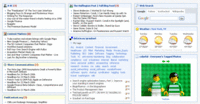The 50 Content Companies that Matter: Nature
![]() For various reasons, much of my focus tends to be in the area of business information. But while the corporate and financial markets often drive innovation in the business info segment, there is quite a bit of innovation in the STM market as well.
For various reasons, much of my focus tends to be in the area of business information. But while the corporate and financial markets often drive innovation in the business info segment, there is quite a bit of innovation in the STM market as well.
Recently, a lot of that innovation seems to be coming from the team at scientific journal Nature. Nature is part of the Nature Publishing Group (“NPG”), a division of Macmillan Publishers Ltd. While many of the companies profiled on this blog are early stage, Nature dates back to 1869. With 400 employees, NPG publishes sixteen journals and four clinical practice titles.
Recently, the New Technology Team at NPG launched Connotea, a social bookmarking site for the scientific community. Connotea is loosely based on del.icio.us, though they have integrated functionality specific to the scientific community. For example, bibliographic information from a number of content sources (Nature, Pubmed, Science, Amazon and others) is automatically fetched when these pages are saved to the site. Connotea also supports the RIS file format, favored by many information professionals, so that users can upload entire collections of references.
 Connotea also includes a wiki-based set of Community Pages, which allow users to write and edit content about the Connotea service. I first found out about Connotea a few weeks ago, when I noticed a number of visitors to Content Matters coming from a link on the Connotea site (in response to a post I did on the Nature vs. Britannica “feud”).
Connotea also includes a wiki-based set of Community Pages, which allow users to write and edit content about the Connotea service. I first found out about Connotea a few weeks ago, when I noticed a number of visitors to Content Matters coming from a link on the Connotea site (in response to a post I did on the Nature vs. Britannica “feud”).
But, Connotea is hardly the only forward-thinking solution from Nature. They have been early adopters of RSS and podcasting, and have even launched a mashup of Avian flu reports with Google Earth. A number of Nature writers and management have blogs, as does even the CEO of parent company Macmillan.
Nature has also taken some steps towards support of the Open Access movement. For those unfamiliar with Open Access, there has been a major movement to get scientific journals to allow their writers to submit their manuscripts to public archives. Since much of the scientific research done today leverages public funding, the OA community argues that the resulting scientific findings should be shared with the wider scientific community. Public Library of Science, another of the “50 Content Companies that Matter” has been a leader in this space. While Nature has not fully embraced OA (it has proposed authors only release their content following a six-month embargo), they have been more supportive of it than many of their peer journal publishers.
In a market where a few large companies control access to much of the critical information, Nature is a shining star for their flexibility, their willingness to test new technologies and their efforts to keep the “community” in scientific community. Nature and NPG are clearly one of the 50 Content Companies that Matter.
























 Clearly, Chevy did not understand the dynamics of the market most likely to use the application – teenagers and young adults. While Chevy may have envisioned users creating ads touting the Tahoe’s spacious interior, ample seating or rugged looks, that’s not what most of the users were thinking about. Instead, they leveraged the desert scenes, ice capped mountains and waterfall imagery to drive satirical snippets focused on the war in Iraq and global warming. For an example of how this works, take a look at the example that I created.
Clearly, Chevy did not understand the dynamics of the market most likely to use the application – teenagers and young adults. While Chevy may have envisioned users creating ads touting the Tahoe’s spacious interior, ample seating or rugged looks, that’s not what most of the users were thinking about. Instead, they leveraged the desert scenes, ice capped mountains and waterfall imagery to drive satirical snippets focused on the war in Iraq and global warming. For an example of how this works, take a look at the example that I created.


